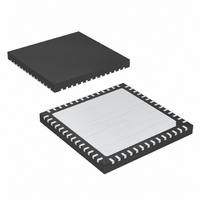MAX5733BUTN+T Maxim Integrated Products, MAX5733BUTN+T Datasheet - Page 20

MAX5733BUTN+T
Manufacturer Part Number
MAX5733BUTN+T
Description
IC DAC 16BIT 32CHAN SER 56-TQFN
Manufacturer
Maxim Integrated Products
Datasheet
1.MAX5732BUTNT.pdf
(28 pages)
Specifications of MAX5733BUTN+T
Settling Time
20µs
Number Of Bits
16
Data Interface
MICROWIRE™, QSPI™, Serial, SPI™
Number Of Converters
32
Voltage Supply Source
Analog and Digital
Power Dissipation (max)
2.5W
Operating Temperature
0°C ~ 85°C
Mounting Type
Surface Mount
Package / Case
56-TQFN
Lead Free Status / RoHS Status
Lead free / RoHS Compliant
The MAX5732–MAX5735 provide a hardware-selectable
DSP-interface mode. DSP mode, when active, allows
chip select (CS) to go high before the entire 32-bit com-
mand word is clocked in. The active-low DSP logic input
selects microcontroller (µC)- or DSP-interface mode.
Drive DSP low for DSP-interface mode. Drive DSP high
for µC-interface mode. Figure 2 illustrates serial timing
for both µC- and DSP-interface modes.
32-Channel, 16-Bit, Voltage-Output
DACs with Serial Interface
Table 8. Configuration-Register Data Format
X = Don’t care.
Table 9. Configuration-Register Commands
20
ERRF
D15
DATA BIT
D10–D0
______________________________________________________________________________________
D15
D14
D13
D12
D11
SING
D14
D13
GLT
NAME
SHDN
ERRF
SING
GLT
DT
X
D12
DT
Error flag; ERRF goes logic-high when an invalid command is attempted. ERRF is cleared each
time the configuration register is read back to DOUT. Clear-register commands C2, C1, and C0 =
111 resets ERRF. Conditions that trigger ERRF include:
Default is logic-low (no error flags); ERRF is read only.
Single device; SING determines the manner in which data is output to DOUT. A logic-high sets the
device to operate in stand-alone mode or in parallel; only the 16 data bits are output to DOUT. A
logic-low sets the device to operate in a daisy chain of devices. In this case, the entire 32-bit
command word is output to DOUT.
Default is logic-low (daisy-chain mode); SING is read/write.
Glitch-suppression enable; the MAX5732–MAX5735 feature glitch-suppression circuitry on the
analog outputs that minimizes the output glitch during a major carry transition. A logic-low disables
the internal glitch-suppression circuitry, which improves settling time. A logic-high enables glitch-
suppression, suppressing up to 120nV-s glitch impulse on the DAC outputs.
Default is logic-low (glitch suppression disabled); GLT is read/write.
Digital output enable; a logic-low enables DOUT. A logic-high disables DOUT. Disabling DOUT
reduces power consumption and digital noise feedthrough to the DAC outputs from the DOUT
output buffer.
Default is logic-low (DOUT enabled); DT is read/write.
Shutdown; a logic-high shuts down all 32 DACs. The logic interface remains active, and the data is
retained in the input and DAC registers. Read/write operations can be performed while the device
is disabled; however, no changes can occur at the device outputs. A logic-low powers up all 32
DACs if the device was previously in shutdown. Upon waking up, the DAC outputs return to the last
stored value in the DAC registers. Default is logic-low (normal operation); SHDN is read/write.
Don’t care.
SHDN
Attempted read of address bits A5–A0 = 111111 (all 32 DACs)
Access to reserved addresses
Access to the configuration register (address bits A5–A0 = 100001 when used with control bits
C2, C1, and C0 = 010 and 011)
D11
DSP Mode ( DSP )
D10
X
D9
X
16 DATA BITS
D8
X
The configuration register controls the advanced fea-
tures of the MAX5732–MAX5735. Write to the configura-
tion register by setting the control bits C2, C1, and C0
= 001 and address bits A5–A0 = 100001. Table 8
shows the configuration-register data format for the
D15–D0 data bits. Table 9 shows the commands con-
trolled by the configuration register.
D7
X
DESCRIPTION
D6
X
D5
X
D4
X
D3
X
Configuration Register
D2
X
D1
X
D0
X











